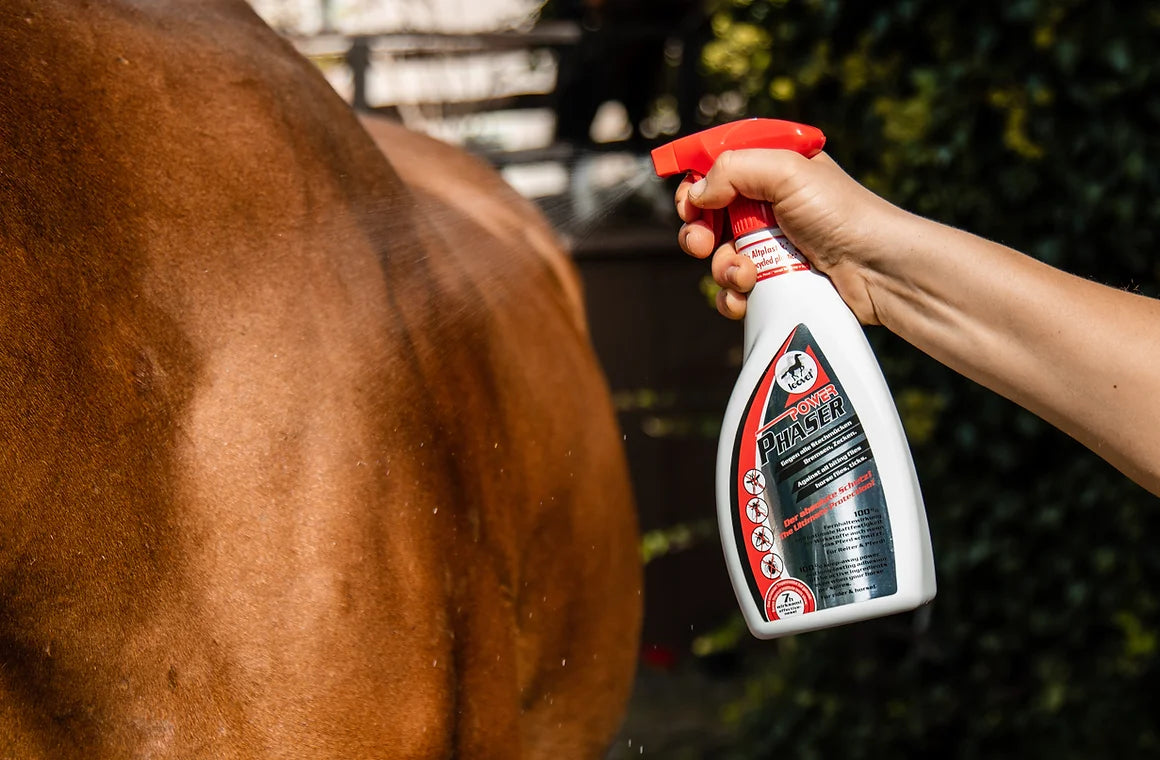Protection is important
Summer time is insect time and protecting your horse from being stung by these pests is very important, especially from the point of view of your animal’s health. Insects bother horses everywhere: in the barn, when working, and out on the pasture. The most commonly encountered insects associated with horses are flies, horse flies, louse flies, botflies, midges and black flies. The most dangerous ones are those that inflict bites. They feed on the horse’s blood and can transfer diseases in the process.
In order to protect horses from insects, a multitude of measures may be necessary. The barn should be kept clean and hygienic – this will help to keep insects away. Pastures should be on dry land as insects prefer wetlands for their habitat. In some cases, it might be wise to take horses inside at certain times of the day. Insects are most active during the twilight hours. Fly masks and blankets can offer external protection. However, if you don’t want to leave your horse “dressed”out on the field or when working, you can provide relief by using insect protection in the form of either insecticides or repellents. Insecticides are substances used to control insect populations by killing the adults, larvae or eggs in their different stages of development. They mostly work as neurotoxins, but often kill off beneficial insects as well as the pests. Most insecticides commonly sold in equestrian sports shops contain the pyrethroids cypermethrin and permethrin, which act as contact insecticides. They block the voltage-dependent sodium channels in the nerve membranes, thus working very fast and efficiently against all insects. Pyrethroids are used in large quantities in conventional farming, which often leads to the development of pyrethroid resistance. Resistance is generally caused by a blockage of the mechanism of action. This requires the insect to come into contact with the active substance, i.e. absorption of the active agent through the skin, lungs or stomach is required. The insecticidal substance then takes effect inside the body.
Those organisms which by way of a genetic variation are not killed by the insecticide, go on to form new populations. Resistance against pyrethroids is developed mostly in species which produce increasing amounts of catabolic enzymes. Pyrethroid resistance can also be acquired. Some species also exhibit altered sodium channels in their nerve cells. Oher characteristic of insecticides are that they can be absorbed by the skin in very small quantities and are stored in the adipose tissue. Alternatives to insecticides are the repellents. The Latin term ‘repellere’ means to repel or to dispel. Repellents are substances, mixtures of substances or formulations which by being applied to the skin, clothes or other materials keep insects away.
Insects are attracted to horses by their chemoreceptors. These chemoreceptors sit on so called sensillae, which represent the smallest unit of the insect’s sensory organs. Chemoreceptors react to smells (sweat), carbon dioxide (breath) or heat (body temperature). Insect repellents interact with the chemoreceptors which insects use to navigate and to communicate with each other, thus preventing the pest from finding the target organism - the horse. There are two types of active substances used in repellents: synthetic and natural. Well-known natural ingredients are essential oils, like tea tree oil, lavender oil, eucalyptus oil, citronella oil, citrepel (p-menthane-3,8-diol), which originates from Eucalyptus citriodora, and geraniol, which is found in geranium oil.
In contrast to synthetic repellents, natural repellents are not as long lasting and have the potential to cause allergies. To avoid skin irritation, contact with the eyes and mucous membranes (nostrils, mouth) should be avoided. Natural repellents cover up the horse’s own body odour and pests are less likely to be attracted. Synthetic repellents have a longerlasting effect - they can be produced with a consistent quality and have undergone toxicological testing. For this reason, many of them are recommended by the World Health Organisation.
One of the best known active substances used as a synthetic repellent is N,N-diethyltoluamide, abbreviated DEET. It is the oldest and best known synthetic repellent. It was developed by the US Army and patented as early as 1946. It has been widely used in insect repellents for both human use and for horses. Depending upon concentration and formulation, protection from pests can be achieved for up to 8 hours. Some of the newer active ingredients in synthetic repellents are icaridin and ethyl butylacetylaminopropionate (IR3535®).
Icaridin acts on the same group of pests as DEET and is quite comparable in its duration of action and intensity. IR3535® (ethyl butylacetylaminopropionate) also has a wide range of efficacy. It is characterised by a high chemical and thermal stability and a long-lasting effect. It possesses no allergenic, sensitizing or toxic properties. Most repellents are available as sprays. Insect repellent gels are also popular, due to their good adhesion and the fact that they make no spraying noises, which can frighten some horses.


